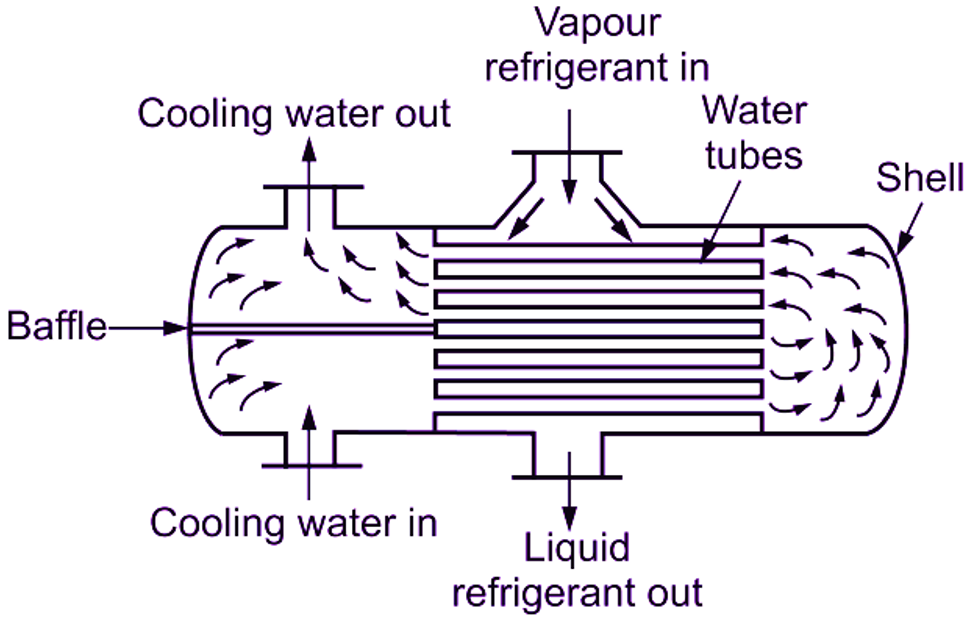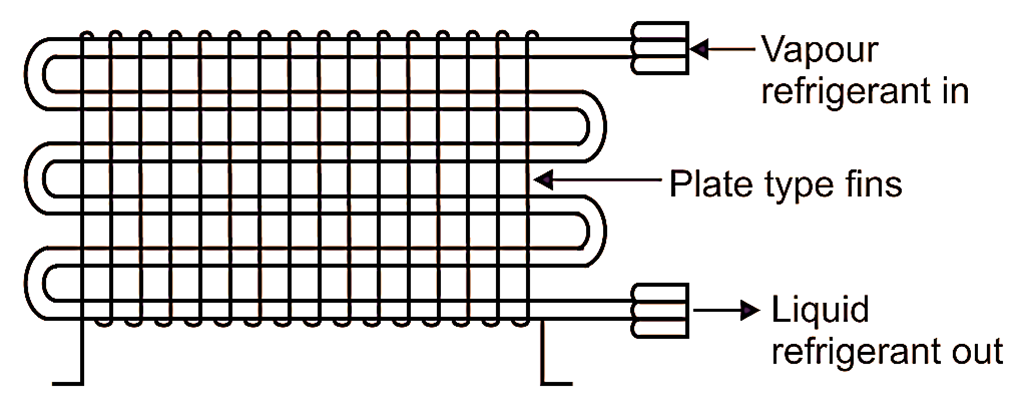
Courses

By Shailendra Singh
|
Updated on 17 Mar 2025, 14:48 IST
Condensers play a pivotal role in various industries, from refrigeration and air conditioning to chemistry and power generation. Despite their ubiquitous presence, many people remain unaware of the intricate mechanisms and diverse applications of condensers. We will explore into the world of condensers, exploring their types, functions, applications, and the underlying principles that make them indispensable in modern technology.
The Fundamental Concept of Condensation
Condensation is a phase change phenomenon in which a substance transitions from a gaseous state to a liquid state. Condensers are devices designed to facilitate this transition by removing heat from a substance, thereby causing it to condense. This process is essential in numerous applications, ranging from refrigeration to power plants.
Surface condensers are commonly employed in power plants and industrial settings. They consist of a network of tubes through which a cooling fluid circulates, promoting the condensation of vapor. The condensed liquid is then collected and removed, leaving behind a more efficient system.

Shell and tube condensers utilize a design where the vapor flows through tubes while the cooling fluid surrounds them in a shell. This design maximizes the surface area for heat exchange, enhancing the condensation process. These condensers find applications in various industries, including chemical processing and refrigeration.

Unlike water-cooled condensers, air-cooled condensers dissipate heat through direct contact with ambient air. This design is commonly found in refrigeration systems and air conditioning units, offering advantages in locations where water availability is limited.


Condensers play a crucial role in refrigeration and air conditioning systems. In these applications, a refrigerant undergoes a cycle of compression, condensation, expansion, and evaporation. The condenser is where the refrigerant releases heat to the surroundings, causing it to transition from a vapor to a liquid state. This process is vital for maintaining the desired temperature in enclosed spaces.
Condensers are integral components in steam power plants, contributing to the efficiency of electricity generation. In these plants, steam produced by boiling water in a boiler is expanded through turbines to generate electricity. The condenser then turns the steam back into water, allowing it to be pumped back to the boiler for the cycle to continue.
In chemical industries, condensers are utilized for various purposes, such as recovering solvents, removing heat from reaction vessels, and facilitating the condensation of volatile substances. Their versatility makes them indispensable in processes ranging from petrochemical production to pharmaceutical manufacturing.
Condensation involves the transfer of heat from the substance undergoing condensation to the surrounding environment. This heat transfer follows the laws of thermodynamics, specifically the principles of conservation of energy. Understanding these thermodynamic principles is essential for designing efficient condenser systems.
Phase diagrams illustrate the relationships between temperature, pressure, and the states of matter. The critical point, where a substance can exist as both a liquid and a vapor, is a crucial consideration in condenser design. Engineers must carefully analyze these diagrams to optimize condenser performance.

Condenser efficiency can be compromised by fouling, the accumulation of unwanted deposits on the heat transfer surfaces, and corrosion, which can degrade the materials over time. Ongoing research focuses on developing materials and coatings to mitigate these challenges and extend the lifespan of condenser systems.
As the world strives for sustainability, researchers are exploring environmentally friendly alternatives in condenser design. This includes the use of eco-friendly refrigerants, improved energy efficiency, and the development of condensers that minimize water consumption in cooling processes.
The integration of smart technologies, such as sensors and automation, is revolutionizing condenser systems. These advancements enable real-time monitoring, predictive maintenance, and enhanced control over condensation processes, contributing to increased efficiency and reduced energy consumption.
Nanotechnology is poised to make a significant impact on condenser technology. The use of nanomaterials and coatings can improve heat transfer efficiency, reduce fouling, and enhance the overall performance of condenser systems.
Heating, Ventilation, and Air Conditioning (HVAC) systems rely heavily on condensers to regulate indoor temperature and humidity. In these systems, a refrigerant absorbs heat from indoor air, undergoes compression, and then releases heat in the condenser to the external environment. This process is vital for maintaining comfortable living and working conditions in residential, commercial, and industrial buildings.
Condensers are integral components in distillation processes, where mixtures of liquids with different boiling points are separated. As vapor rises through a distillation column, it encounters a condenser where it is cooled and condensed back into a liquid. This allows for the collection of purified substances, making condensers essential in industries such as petrochemicals, beverages, and pharmaceuticals.
In laboratories, condensers are frequently used in various experimental setups. For example, in chemistry, reflux condensers are employed to prevent the loss of volatile substances during reactions by returning evaporated solvents back to the reaction vessel. This ensures efficient use of chemicals and minimizes waste.
Geothermal power plants harness the Earth’s internal heat to generate electricity. Steam, produced by tapping into underground reservoirs of hot water or steam, is directed through turbines to generate power. Condensers are then used to convert the steam back into water for re-injection into the Earth, completing the geothermal energy cycle.
Condensers contribute significantly to energy efficiency in various systems. For instance, in HVAC systems, energy recovery ventilators use condensers to transfer heat and humidity from outgoing air to incoming air, reducing the overall energy consumption for heating and cooling. This principle is crucial in achieving sustainable and energy-efficient building designs.
Cogeneration, or combined heat and power systems, use the same energy source to concurrently produce useful electricity and heat. Condensers play a key role in these systems by recovering and utilizing the excess heat generated during electricity production. CHP systems are valued for their high efficiency compared to conventional power plants.
| Also Check |
| Prime Number Program in Java |
| Fibonacci Series in Java |
| Database Concepts |
| Binary Code |
| Hypertext Transfer Protocol (HTTP) |
| USB - Universal Serial Bus |
A condenser in an air conditioning system is primarily responsible for facilitating the phase change of refrigerant from a vapor to a liquid. During this process, heat is released to the external environment, allowing the system to maintain a comfortable indoor temperature.
In power plants, condensers play a crucial role in converting steam back into water after it has passed through turbines to generate electricity. This condensation process allows the steam to be recycled and reused in the power generation cycle, contributing to the overall energy efficiency of the plant.
In distillation processes, condensers are vital for the separation of liquids with different boiling points. As vapor rises through a distillation column, it encounters a condenser where it is cooled and condensed back into a liquid. This enables the collection of purified substances, making condensers essential in industries such as petrochemicals and pharmaceuticals.
Condensers often face challenges such as fouling, where unwanted deposits accumulate on surfaces, and corrosion, which can degrade materials over time. Ongoing research addresses these challenges through the development of advanced materials and coatings that resist fouling and corrosion, ensuring optimal performance and longevity.*
With the integration of smart technologies, condenser systems are becoming more efficient and manageable. The use of sensors and automation allows for real-time monitoring, predictive maintenance, and enhanced control over condensation processes. This integration contributes to increased efficiency and reduced energy consumption in various applications.